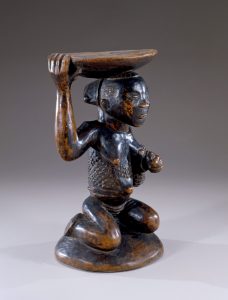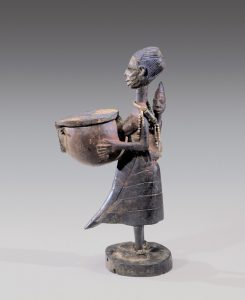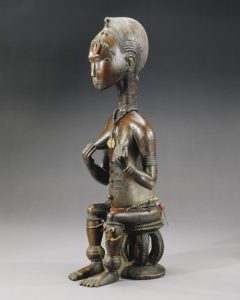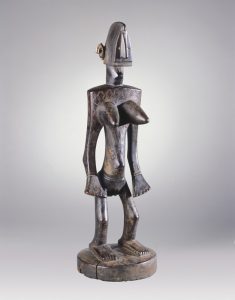
Caryatid stool with maternity figure, 19th century, Luba artist, wood, 16 x 9 x 8 1/2 in (40.64 x 22.86 x 21.59 cm), Bequest of Victor K. Kiam, 77.140
Many sculptural works have been created and used as devices to help ensure married couples are able to procreate. One of the most pervasive concerns of African societies is continuity (1). This is because the future of the family and the group depends on the ability of the present generation to sire and bear children (2). An individual’s sense of social and biological completeness lies in his or her ability to become a parent, for one must depend on one’s children for the proper respect and consideration that is due age. Children not only guarantee the well being of the individual in life, they also provide a proper burial and ensure the transition of the spirit of the parent to the afterworld to take its place as an ancestor and possibly to be reincarnated as a member of the family.

Agere Ifa of a standing maternity figure, 20th century. Yoruba artist, Wood, glass beads, iron and string, 12 7/8 x 3 3/4 x 5 in (32.7025 x 9.525 x 12.7 cm) Museum purchase, Robert P. Gordy Fund, 90.35
There are numerous cultures that created art objects for the purpose of ensuring human fertility and other kinds of fertility that includes, for example, agricultural abundance for the sustenance of the group. In some societies, the birth and dedication of a child is incomplete without the use of art objects. Such objects are created (mostly carved) in a figurative way and as a concept of parenting as a sense of continuity. Maternity in Africa embodies complex ideas vital to the perpetuation of human society. Images of women holding children may reflect a number of ideas. For example, they may represent maternal ancestors and serve as symbols of lineage or clan forbears, the generalized and incarnate dead (3).

Asie Usu, seated female figure, late 19th century, Baule artist, Wood, brass, carnelian, glass, puka shell, cloth string, 22 1/2 x 7 x 8 5/8 in (57.15 x 17.78 x 21.9075 cm), Bequest of Victor K. Kiam, 77.159
The Asie Usu or female-seated figure in the African gallery at NOMA encapsulates some of these ideas. Elegantly carved, with intricate body scarifications that suggest her importance as a female. The various body adornments include wrists and ankle bracelets, and an assortment of beads that wrap around her waist. She also wears a necklace made of beads and a metal pendant. These material attachments speak to her grace and beauty as a maternal ancestral figure.
Nyeleni or standing female figure is another maternal figure that symbolizes womanhood, but also complements the expectation of fertility in the community. Her sturdy appearance, rendered in a cubic style, suggests her strength to procreate and also nourish the community. Such powers are the component that endears maternity ancestors to many African cultures.

Nyeleni, standing female figure, 19th century, Bamana artist, Wood, string, cowrie shell, iron, 24 x 7 1/2 x 7 1/2 in. Bequest of Victor K. Kiam, 77.254
—Ndubuisi Ezeluomba, Françoise Billion Richardson Curator of African Art
(1) Sieber & Walker 1989
(2) Sieber, 1988, Mbiti, 1969
(3) Cole, 1985, 8
NOMA is committed to uniting, inspiring, and engaging diverse communities and cultures through the arts — now more than ever. Your gift will make a direct and immediate impact as NOMA welcomes our community back to the museum and sculpture garden, plans new exhibitions, and develops virtual and at-home arts education resources for school partners.
